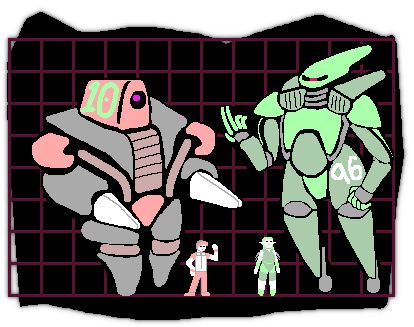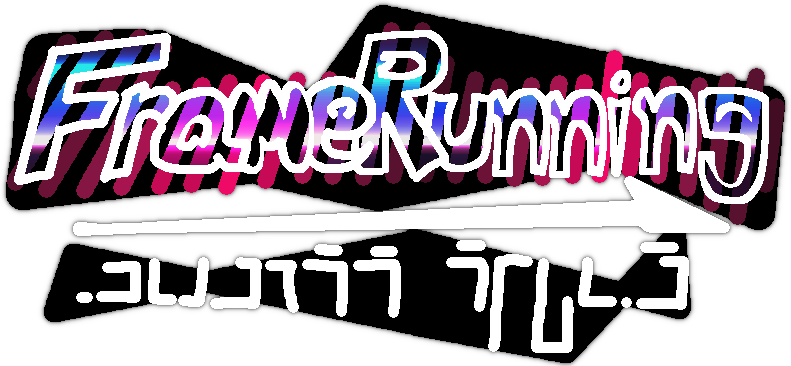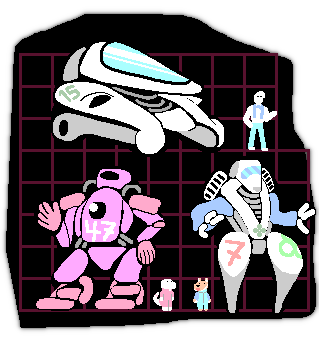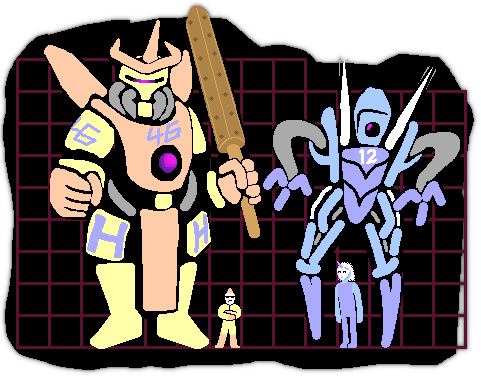Frame Running
Frame Running is an international vehicular racing/combat sport enjoying moderate public attention at this time. It involves the use of modified repurposed military surplus frames (3-5 meter tall mecha with fighter-like plasma engines) which are then raced along the ground and through the air over bizarre three dimensional courses many kilometers long.
Racers battle for physical supremacy; with the gladiatorial aggression of stock racing, the technical finesse and sophistication of high-class auto-racing, the texture in manoeuvring of boat-racing, the sheer speed of fighter-jets, the sheer violence of ice-hockey, the grappling and striking of mixed martial arts - and the larger than life personalities of pro-wrestling.
Frame-Racing hit the intergalactic mainstream around Aleph in early pa_250, but racing leagues at local levels lay claim to Frame Running as early back as pa_225, or in the Lorath Matriarchy's case, brought it with them.
History
| The T-501 Rideau Mechanical Combat Frame was first marketed and sold for PMC use in pa_232 around the Aleph Cluster, moving onto frontier worlds where the frame was sold to law enforcement in PA 237, and to civilians in PA 240. Customers of all walks report the machine is robust, fast, works well for transport due to its heavy thrust/weight ratio translating to excellent lifting capacity. For the civilian market, it could perform large-scale labour work like construction with minor modifications, without the fear of it being stolen or destroyed by any intervening parties. Based on modifications and sales data from One-Stop Frame Garages, a niche has also emerged for racing these frames, and I suggest we open new markets and cater to this emerging customer base. Preston Mechanics Annual Earnings Report, section 44-2: Mechanical Frame Sales Data, commissioned in PA 242 |
The success of the T-501 Rideau and similar frames among civilians soon bore into cocky parties trying to see whose frame was fastest, or flashiest. Disused, mined-out transport paths and erected temporary settlements became stomping grounds for these races: Hot thrusts glassing the dirt and sand the same way feet turn grass into paths. Without the money to afford more advanced field control, cash was poured into power plants, the shape and aerodynamics of the hull and other characteristics to squeeze out that last ounce of performance and advantages.
When chop shops begun working overtime to cater to these needs, fast charge capacitors became a rapid favourite as what was once pure racing evolved: The fierceness of competition and lack of oversight morphed the stock-frame racing into a combat sport - with sharp aggressive punches and sumo-like grappling while darting down the course. Both fought to dominate without clipping the edges of the course or ground enough to total their machines.
The sport swelled in popularity, and novelty stations became local broadcasts became big name stations became sponsorships became a league of its own. It's a sport that's one part high-octane racing to two parts speed skating to one part mixed martial arts fighting to two parts professional wrestling. The sport attracted a combination of dangerous talent and larger than life personalities after spilling out into the mainstream, and a recognised name was put to the sport's face: Frame Running.
Growth Spurts in the Sport
When the money begun pouring in, the technology level of competition rose beyond chop shops and bigger powerplants. Field-manipulation technologies and high-scale gravity manipulation were banned in the larger leagues, leaving only low end gravatic adjustments on the table for extra manoeuvring, and power sources were divided into two categories - fission generators or capacitors. At this point, the sport split in two: Some going the route of big heavy reactors that could drive powerful engines for high speed and others going the route of capacitors, using pit-stops to recover and their sheer lightness to succeed in corners.
When the sport went vertical with big open areas of holographic track, pilots would ignore the track and beeline a direct vector to the next airborne checkpoint, totally ignoring it. Dissatisfied, an incentive was added by promoters: An induction field within the tracks boundaries which could feed frames more energy than their generators could put out: Allowing heavy reactor types to pick up more speed (which could become a serious problem when cornering) and for capacitor types to hurry up.
Now the key wasn't to stay off the track: It was to kick your opponent off the track and out of this high speed induction slipstream. The same slipstream track technology was also issued to the track itself, discouraging pilots from cutting corners or using short-cuts as the lost time simply wouldn't be worth it.
As time went on and legitimate promotions arose with fans and money to spare, tracks rapidly evolved from racing through checkpoints in natural environments, trade-routes, factories and terra-forming equipment to constructing massive industrial roller-coaster like tracks with deliberately designed corners, twisted flat surfaces and cants designed to test even the most experienced pilot with high-powered induction straights where the machines could really show off their top speeds.
The Next Evolution
Even stranger, transformations were introduced for aerodynamic purposes: Some as subtle as locking joints or positioning things differently, others locking the frame into a hull shape resembling a cross between a racing boat and an exotic sports car. Two general forms became popular: Single-nose, which pointed the legs rearwards, excelled at cornering where the torque exerted from the engine position verses the nose meant it could swing itself round and drift corners with ease.
The other, twin-hull, set the legs up front, using them to breach sonic shock-waves when accelerating or decelerating over the body with much greater ease though its thrust came from the middle and front, affecting its handling. Naturally having these two sharp forward facing surfaces with excellent shock-absorption that came with legs was nothing short of brutal when ramming.
Depending on the circumstance, pilots would switch between these two modes of movement: either sacrificing their ability to side-step and dodge for extra speed or sacrificing their top speed to make unusual manoeuvres, drift turns, skim like ice-skaters, land and hover staying close to the ground (as is mandated in some sections of the tracks) or naturally, what everybody came to see: a brawl.
These transformations added minor weight and often extra plating which was useful when fighting or manoeuvring as air control surfaces – and were legal only under the technicality that they would be used as such – promoters and audiences turning a blind eye until transforming frames became the norm.
Rules
The rules of Frame Running are actually very simple:
- Without leaving the bounds of the track, get from point A to point B in as shorter time as possible.
- Special altitude limits must be observed (eg: if allowed to fly or only boost-skim ground)
- No unmanned racers.
- No real names/real identities. All racers must adopt a pseudonym.
- All sponsors must be worn and plainly revealed.
- Performance enhancing drugs are essential and a good source of sponsorship.
- A set number of laps may be required or enforced.
- Physical intervention between teams is not only allowed, it is also encouraged!
- As are personal grudges and arguments.
- A certain theatrical flare is necessary to get sponsorship attention.
- Adhere to the mechanical rules of any given promotion (eg: are weapons legal?)
- Promotions are not responsible for the health of pilots on the track.
- Proof of race fixing is an instant ban/exclusion from the sport.
- First to the finish line wins.
Technical & General Performance
The rules of the race may be straightforward, but technicians, engineers, pit crews and chop-shops involved in Frame Running pay close attention to these rules.
- Antimatter is commonly banned for its 100%+ fatality rate in a crash.
- Spacial manipulation equipment (eg: distortion fields) are banned.
- Gravity manipulation must be kept to a maximum of 1G of acceleration only.
- Soft plasma barriers and wake-style field projectors are recommended.
- Casimir cooling systems are mandatory.
- Intention recognition control systems are banned.
- Primarily AI driven control systems are banned.
- The pilot must be inside the frame during operation.
- Meta-materials are banned (eg: quasicrystal)
- Sharpened implements of military grade hardness are banned.
- Electronic countermeasure and jamming systems are banned.
- A frame must be no smaller than 4 meters and no larger than 9 meters
- The capacity for high speed flight (>mach 1) is mandatory
- The use of a Quicksave (detailed below) is mandatory for organised competition.
Items of interest
Promotions
A professional frame-running promotion (also federation or fed) is a company or business that regularly runs races involving professional Frame-Running. “Promotion” also describes a role which entails management, advertising and logistics of running a racing event (see promoter).
Within the convention of the event, show and race, the company is a sports governing body which sanctions Frame Running and gives authority to championships. It is also responsible for determining divisions, rankings, etc. of racers and teams. Sometimes, promoters get directly involved in the theatrics of the pilot's kayfabe, but this behaviour is now rare due to the risks and deadliness of Frame Running.
Promotions differ in two types: Annual Grade-Zero and Monthly Tours.
Constance
Barely legal in most cases, Constance is glorified street-racing organised outside of the framework of a promotion. Its backbone is in the betting money, and the chance for teams and pilots to draw the attention of bigger promotions with flashy looking frames, big personalities, or keen piloting. Without gimmicks like championship points or obstacles, it all comes down to pilot ability and machine specification to win the races.
Many promotions publicly disavow the legitimacy of Constance frame-running, but shrewd promoters keep an eye on the circuit to scout for hot talent. Runners who have “done their Constance” carry their cred into the mainstream, and aren't to be taken lightly. Constance generally operates at Grade 3, with limited protections, minimal oversight, and the possibility of not getting paid by fly-by-night bookies.
Monthly Tours
Monthly Tours serve as the bread and butter of televised Frame Running, leaning toward the more entertainment-like aspects as a sort of touring theatre troupe of Frame-Racing Combat (or Running) and are usually where pilots will learn their trade and cut their teeth.
Moving around the world, or even across planets and systems, promotions rent tracks produced by the AGP. Wealthy promotions build their own track infrastructure, or re-purpose existing equipment and locations rented legally from city states and businesses sponsoring the events.
Here most of the “larger than life” personalities take form and the majority of teams perform on this level, with promotions working Grade 1 and Grade 2. There are five types of races in the monthly tours:
- Showdown - 2 teams, 3 frames per team.
- Fullrun - Up to 6 4 man teams.
- Baton Pass - Races with obstacles graded into different types so each member engages their strength individually.
- Ace Championship League - A series of races involving single team members racing for championship points and wins. Minimum of to 30 competitors, up to 60.
- Open Championship League - A series of races involving entire teams racing for championship points with mixed Frame configurations competing against each other. Minimum of 30 competitors, up to 90.
Grade Zero
 The Grade-Zero Intergalactic Championship (known as Grade Zero, G0) is the highest class of frame-running. The “Grade”, designated in the name, refers to a set of strict operating rules in which all participants must comply – banning many fieldic technologies and systems but most of all creating a minimum spec that all machines must meet.
The Grade-Zero Intergalactic Championship (known as Grade Zero, G0) is the highest class of frame-running. The “Grade”, designated in the name, refers to a set of strict operating rules in which all participants must comply – banning many fieldic technologies and systems but most of all creating a minimum spec that all machines must meet.
([*] Signifies rules common accepted convention in Monthly Tour and is stated here explicitly):
- All frames must use three aggressive powerplants and two passive powerplants (making them larger and heavier)
- All frames must use sanctioned powerplants, with approved after-market modifications by the governing fed.
- All frames are expected to reach a minimum speed of mach 7.3 and ideally around 10 to be competitive.
- All frames must use a quicksave-device
- All frames must fit a catch-receiver system for use with the pits-system
- Hand-held weapons are allowed only for specific events and are issued by the governing fed.
- All frames must fit sensors and computers specifically provided by the governing fed: Programming is the teams prerogative.
- Weapons are authorized through the pad-collection system and expected to fit a pad-receiver hardpoint.
- Aerodynamic surfaces can be sharpened as shunts
- Unmanned frames are banned*
- Constructs (replica minds) and Maidenhands (designer minds) are banned1).
- Machine Intelligences (naturally formed minds) are legal
- Skills must be naturally cultivated in experience and cannot be copied, cloned or downloaded.
- Advanced field systems which negate inertia are banned*
- Advanced field systems which act as primary control surfaces are banned
The G0 season consists of a series of races, held throughout all of known space on purpose-built circuits, public roads and designer tracks in the later stages. The results of each race are evaluated using a points system to determine two annual galactic championships: One for pilots, one for the constructors of the frames themselves.2)
The running-pilots, constructor teams, track-officials, organizers and circuits are all required to be holders of valid Supra-Licences, the highest class of frame-running and frame-racing issued by the governing fed. It is here that teams and pilots from the Monthly-Tour promotions meet here to butt heads annually at the highest level.
Famous/Noteworthy Teams
The following teams have been noteworthy competitors throughout the Grades of competition in Frame Running.
A list of notable individual racers can be found on this link:
Hrul
 Sporting heavier craft, Hrul are big fans of military doctrine heavy frames, using machines altered almost only in powerplant and software alone. With good top speed and so-so handling, they're known for drifting around corners by the skin of their teeth and trying to get into fisticuffs rather than relying purely on piloting skill.
Sporting heavier craft, Hrul are big fans of military doctrine heavy frames, using machines altered almost only in powerplant and software alone. With good top speed and so-so handling, they're known for drifting around corners by the skin of their teeth and trying to get into fisticuffs rather than relying purely on piloting skill.
Their heavier craft is very resilient and can often strike track walls at top speed and still remain competitive. Known to play the monster-heel, impending and refusing to go down, hunting down those they chase.
Rotherford
 A newcomer from the Unity Protocol, Rotherford are a Greaseheart team who recently made a face-turn. Viewed as a true neutral, they bring experience as ex-airbike racers to the table. They are particularly known for using a technically less advanced machine but relying more on physical aggression, sharp instincts and excellent maneuverability.
A newcomer from the Unity Protocol, Rotherford are a Greaseheart team who recently made a face-turn. Viewed as a true neutral, they bring experience as ex-airbike racers to the table. They are particularly known for using a technically less advanced machine but relying more on physical aggression, sharp instincts and excellent maneuverability.
Particularly infamous for trying to legalize the use of ballistic weapons in the sport, which hangs on a technicality of municipal broadcast and sponsor rights and whether or not Rotherford are skilled or experienced enough to give the Greaseheart population of Unity interest in the sport.
Nepiu
 A hybrid team of humans and MI's, Nepiu demonstrate unusual technical excellence and are huge fans of getting up close and personal. Often very aggressive, what their machines lack in physical resilience they make up for with well balanced performance, excellent acceleration and often fighting the war rather than the battle. Their machines emphasize smart computer control, with energy regulation and backup capacitors being a big part of their main strategies: While this makes their frames heavier, their operational envelope is much wider and generalized.
A hybrid team of humans and MI's, Nepiu demonstrate unusual technical excellence and are huge fans of getting up close and personal. Often very aggressive, what their machines lack in physical resilience they make up for with well balanced performance, excellent acceleration and often fighting the war rather than the battle. Their machines emphasize smart computer control, with energy regulation and backup capacitors being a big part of their main strategies: While this makes their frames heavier, their operational envelope is much wider and generalized.
Fuyu
 Fuyu: sourced from a human word for Winter as well as a big middle-finger (“f\*\*k you”), Fuyu are a Maidenhand team grandfathered into the sport3) who largely play the role of heel or villains, in kayfabe preying on weaker amateur teams and pulling on the strings local nationalism to turn heads and gain cheap heat.
Fuyu: sourced from a human word for Winter as well as a big middle-finger (“f\*\*k you”), Fuyu are a Maidenhand team grandfathered into the sport3) who largely play the role of heel or villains, in kayfabe preying on weaker amateur teams and pulling on the strings local nationalism to turn heads and gain cheap heat.
They deliberately exhibit unlikable characteristics like arrogance, cowardice or contempt for the audience themselves and often play up the commonly perceived superiority complex that Maidenhands have. Their team's raison det're is almost entirely speed-speed-speed, competing exclusively with an aggressive powerplant, their machines having re-enforced quicksave escape mechanisms should they hit the edges of the track hard instead of just clipping or scraping (as they often do through most turns). Their combined sponsors are one of the pillars of funding for the sport.
Delta City Mavericks
Born from drag-races beginning as early as cars and airbikes, this team of hardcore engine tweakers do whatever they can to win, bending the rules on every conceivable front and just occasionally breaking them with the hope either nobody notices or the spectacle is so immense that they'll be praised either for their ingenuity or the sheer heft of their balls. The team holds a certain “Hard Knock Brand”, with leather jackets, spikes and a punk aesthetic.
In essence, they're the asshole who not only goes under ring to get a chair but then goes back for tables, ladders, then tacks and eventually barbed wire. Proud of their home city, they use any excuse to bring attention to “the great DC”, whether its through branding or smack-talking literally anyone who doesn't share the same geographical preference. In their own words: “you either come here, you see paradise for what it is or you kindly go fuck yourself with a five iron, something we're more than happy to help you with”. There are rumours of pilots eloping 'cultural exchanges' with Tittenfriek though nothing concrete has surfaced.
CloverBark
This all-MBF team is the corporate offering of Cloverpaw. They stick to standard internals on all the machines they use with only a little amount of customization to make it easy for their pilots to use.
The customization is purely aesthetic, otherwise, opting for a “cute as possible” approach. The team is often a target for the heels to get easy audience rallying behind whatever team is playing the face for the day.
Selzen
A flashy team, all about getting all the sponsors and fans through show-offy play. They’re low, race result wise, but they bounce between popularity rankings. The frames are mostly light, delicate things, and they maintain a playful but nonagressive persona.
Harmony
The members of Harmony are from Balance's four populations of Oddbodies. They have an aggressive team rivalry (internally), and defend each other fiercely from external aggressors. Each frame on the team reflects its respective kingdom, and they’re good all-rounder machines - but they succumb to infighting and team conflict.
Candor Medical Research
They’re known as the goodwill team. They help injured or downed rival machines on the track, and are often the ones who take on the newest safety measures for testing before anybody else.
Jula
A primarily Rolaan team using magitek-infused frames frames. They rely on coordinated attacks, often using one member as bait. While strong as a team, they are terrible individually. They have a sportsmanlike, hunting lodge persona.
Jasmei
 (Unavailable until Lorath First Contact) Non-committal, Jasmei, a Lorath team are big fans of experimenting. Their machine differs from track to track more so than that of their opponents, with the appearances of their machines differing wildly. While their successes aren't always consistent, those that they do have tend to be spectacular.
(Unavailable until Lorath First Contact) Non-committal, Jasmei, a Lorath team are big fans of experimenting. Their machine differs from track to track more so than that of their opponents, with the appearances of their machines differing wildly. While their successes aren't always consistent, those that they do have tend to be spectacular.
Jasmei is part of the original Lorath generation of the sport. In terms of personality, they are perhaps the least outlandish or cartoonish, consisting mostly of down to earth people who happen to run Frames.
Tittenfriek
 (Unavailable until Lorath First Contact) An odd mix of Greaseheart grittiness, idol culture and the Lorath matriarchy, Tittenfreik (a portmanteau of ti'tara and enfreik, meaning speed and idiot accordingly with a third obvious combined meaning) are a twin duo of two lmanel star pilots: Biological twins known for their dripping sexuality and harsh attitudes, wrapped in satire and irony.
(Unavailable until Lorath First Contact) An odd mix of Greaseheart grittiness, idol culture and the Lorath matriarchy, Tittenfreik (a portmanteau of ti'tara and enfreik, meaning speed and idiot accordingly with a third obvious combined meaning) are a twin duo of two lmanel star pilots: Biological twins known for their dripping sexuality and harsh attitudes, wrapped in satire and irony.
On the track, the two are diametrically opposed on almost every point: each acting together as they move through the ranks as almost a single unit executing coordinated maneuvers and attacks which are conventionally impossible thanks to psionic bonding on their part. The two deploy differing machines to compliment one another. Their large egos, personalities and stylings lend them well to sponsorship, as does their love of substance abuse which in turn re-enforces their brand recognition.
See tittenfriek
Racing Classes and Codes
Frame Running was initially founded on open competition, with a plethora of different shapes, features, and capabilities being brought by each runner. The need arose to begin categorising the frames as the differences became clearer. Organisers and promotions agreed on a simple Frame Code to categorise frames from a glance.
Let's look at the Underdog, Frame #7 of team Cloverbark run by Fido in the Aleph Frame Running Championship. It has the following code: BF.PP.TF1+SL.
This translates to a Fighter Build-Type, with a Passive powerplant, a Single-Hull Transformation capability, and a Slipstream System.
Quicksave
The quicksave is designed to wrap the pilot in shock absorbent, thermally protective foam. Commonly, the frame either self-destructs, bifurcates or explosively ejects (akin to an ejection seat) the quicksave pod as a bouncing sphere which then rolls to a stop. It is able to withdraw incredibly harsh atmospheres, extended durations without oxygen, intense heat, severe cold and drops at speeds at over 200mph.
Frames without a Quicksave installed are suffixed with a !, and barred from competing in Grade One or Grade Zero races for safety and health.
Build-Type [B*]
Any sufficiently large team is expected to bring only four chassis to any given race weekend in a class 1 or class 0 circuit. These chassis are generally split into four classifications.
While they can be modified and class-changed, they must arrive in stock condition to be inspected by judges prior to entering the track. Qualifiers are all done in a single class of machine for all teams, which is randomly selected.
Speed [BS]
Raw output, speed machines usually use an aggressive powerplant and do their best work going in a straight line, packing extra cooling gear to make the most of an instant induction slipstream boost for as long as possible. Often tend to have trouble turning and drift around a lot, demanding extra compensation from pilots to make up for the lack of aerodynamic sharpness, sometimes nicknamed 'grip'.
Agility [BA]
The opposite end of the spectrum, agility machines can turn and change their movement direction very very quickly. They excel in tight twisty tracks and often have large capacitors to spend induction boost exiting turns or executing tricky manoeuvres.
Fighter [BF]
Heavier machines sacrificing both speed and agility, fighters tend to be about surviving repeated blows and launching their own - their physical fortification doubling as extra cooling to play catchup to make up for their lack of speed. Good all rounders otherwise, they pack agility to turn end to end but not shift their movement direction, allowing them to fly backwards to absorb a hit more easily than their more race optimized counterparts. Basically brawlers.
Prototype [BP]
A special classification reserved only for Class 0 courses, Prototype machines are independent of traditional schemes and can often switch modes between the three on the fly in software. Specifically, their components are setup as such that they gain far high performance at the cost of said components only being able to survive a single race: the cooldown after the end of a race often expanding, buckling and destroying critical components.
The rules specifically state Prototypes must be larger to accommodate three aggressive powerplants, two passive powerplants simultaneously and whatever extra cooling gear is required. They often cost millions to build and are the pride of any constructor team.
Powerplant [P*]
 Without a powerplant, the frame cannot run, and there cannot be a competition. There are two broad schools of thought on how to power a frame, with a middle-ground between them:
Without a powerplant, the frame cannot run, and there cannot be a competition. There are two broad schools of thought on how to power a frame, with a middle-ground between them:
Passive [PP]
A series of capacitors/batteries are fitted in place of a conventional powerplant. Craft are much much lighter and navigate courses with far greater ease, relying primarily on induction slipstreams on course straights. Often surprisingly durable and long-wearing, but lacking in top speed. Much safer.
Aggressive [PA]
Gone is the capacitor in favour of a regulated fission or fusion reactor. Though far heavier, the top speed of craft are far greater. Unwieldiness is compensated for with far greater acceleration and induction slipstreams translate into maxing the machines out, potentially burning components out with how hard and how fast they are pushed. Fatalities are much greater.
Mixed [PM]
A mixed powerplant setup uses both capacitors and a suitable fission or fusion reactor. Usually found on Prototype builds to service their incredible demands on the runner and frame, but this configuration finds its way into less complex builds too. A happy middle-ground with some risk, and a balance between speed, durability, and component wear.
Transformation [TF*]
A newer feature, transformation involves changing elements of the frame for aerodynamic or induction receiver purposes. Some are as subtle as locking joints in place or positioning things slightly different: Others shifting the entire hull-shape of the frame to resemble a cross between a fighter-jet, racing boat and exotics sports car.
Depending on the circumstance, pilots would switch between these two modes of movement: either sacrificing their ability to side-step and dodge for extra speed or sacrificing their top speed to make unusual maneuvers, drift turns, skim like ice-skaters, land and hover staying close to the ground (as is mandated in some sections of the tracks) or naturally, what everybody came to see: brawl.
These transformations added minor weight and often extra plating which was useful when fighting or maneuvering as air control surfaces – and were legal only under the technicality that they would be used as such – everyone turning a blind eye.
Transformation generally comes in three main classifications:
Subtle [TFS]
The most common type, this involves the aforementioned locking of joints and other systems and is commonly used either during high speed portions to reduce torsion on joints or to prepare for harsh crashes.
Single Hull [TF1]
The first class of full transformation, single hull or single nose has a single pointed nose like a fighter-jet and the legs pointed rearwards. They excel in cornering where torque exerted from the engine verses the nose means the craft can swing itself around corners very aggressively.
Twin Hull [TF2]
The second class of full transformation, twin hull or dual nose has two long forward front fuselages composed of the legs and usually has the upper body toward the rear. They excel at breaching sonic shockwaves when accelerating or decelerating during faster portions of courses and are almost standardized in the more advanced teams of Grade Zero.
Unfortunately in this mode, thrust mostly comes from the middle or front of the craft, which is great for high speed stability but poor for cornering. Naturally, having two sharp forward facing surfaces is great for crashes or strikes, especially when attacking and can be nothing short of brutal when ramming.
Special Functions [+]
Special functions are components and systems not available to all frames on all levels of competition, and help differentiate and set frames apart. Generally, each introduces a new complex dynamic to racing and many courses are focused around exploiting a specific trait to its maximum.
Slipstream [+SL]
Available to most professional level frames in specialist areas of the track and differing densities, these are specially designed transparent plasmas carrying high voltage from the track itself directly to the frames and their power plants at a faster rate than their own reactor or capacitors can drive the engines.
Through these, frames experience less friction (better acceleration) and can either stock up on energy for later or gain an immediate speed boost. Induction slipstreams are often used to discourage cutting corners.
Immediate use of induction slipstreams leads to very rapid overheating of the frame itself and can destroy explosively it on longer tracks.
Grappler [+G]
While grabbing and grappling is the bread and butter of Frame Running, some frames are fitted with the means of grabbing and holding on tight with a vice-grip rather than wrestling them. Other forms of violent adhesion through magnetism, magic cloth, or mucus fall under this category too.
Ranged Grappler [+GR]
Some frames are fitted with ranged grappling capabilities via means of hooks and cables, electromagnetic beams, or lengths of empowered cloth. Ranged Grappling has uses including hitch-hiking a ride off another frame, and sling-shotting themselves off competitors and the environment to aid with tight turns.
Visual Misdirection [+VM]
As a means of defence, some Frames utilise holograms or illusions to conceal their exact position from enemy runners. Many conventional cloaking device packages cannot keep up with the high-speed demands and heat output to completely conceal a sports frame, but they can obfuscate its figure and outline, making the frame harder to intercept or target.
Commander [+CO]
Some teams nominate a frame and runner that excel in coordinating with teammates and oppressing competitors throughout a circuit, by means of rehearsed team tactics and strategic communication with the pit crew in the loop.
Tank [+TK]
A code given to Frames with significant heavy armour plating and bulky construction. In addition to being highly durable, difficult to grapple, and hard to throw off-kilter, frames like this excel at maintaining a top speed, but have trouble with acceleration.
Stripped [+ST]
Some frame builders opt for a stripped down design, doing away with exterior panelling to reduce weight and increase their speed as a result. The frame's aerodynamics may be affected by the irregular shape but the reduction in weight offsets it, at the cost of being more vulnerable to damage.
Disposable Boosters [+DB]
Some frames might carry an array of disposable, single-use booster charges. Prior to being fired, they add additional weight and bulk to the frame, but once fired and discarded the lighter weight of the frame lets it capitalise on the gains made in boosting.
Weaponry [+W**]
A staple in the Aleph frame running scene, and a new sight the last two or three years since human teams began getting involved in Lorath Frame Running, Weapons have been introduced into the sport alongside conventional ramming, striking, grappling and clinches.
Though not always used, they offer ranged attacks or tactical capabilities usually focused on slowing an enemy down, knocking them off kilter, or throwing them behind as opposed to outright destroying them though some courses and rulesets emphasize destruction.
Melee [+WML]
The simplest addition to a Frame, a sanctioned melee weapon for Frame Running is less likely to kill or injure a target than it is to knock them off kilter or push them away. A melee weapon gives a Frame reach compared to a grappler, and opens up new tactics on the circuit.
Pre-fitted [+WPF]
Pre-selected from a gallery or randomly chosen, pre-fitted weapons add weight to the frame but also offer offensive capabilities. They usually include photon missiles, plasma systems, ECM devices, shield generators and disposable booster units.
Beam Transfer [+WBT]
Similar to pre-fitted units, frames taking advantage of this come with all weapons - but not the ammunition, which is transferred when a frame rides over a marked speedpad: On the upside this makes frames much lighter, retaining their agility and speed but on the downside means weapons are only available if a speedpad is used, so they must push their advantage.
Famous/Noteworthy Courses & Tracks
This is a quick rundown of the notable courses created by various Frame Running promotions, or plotted from urban spaces living and dead, through space, and landscapes. A detailed listing of the tracks by grade can be found here:
| Grade | Name | Location | Features | Length |
|---|---|---|---|---|
| 0 | Stardancer Station | Acala | Space-Station, Atmos/Vacuum Transitions, Short (for Grade Zero) | 136.5km |
| 0 | Noval | Lor II | Corkscrews, Free-Fall and Death-Glide | 396.4km |
| 0 | Straights | Nyli II | Braided Racecourse, Moebius Spiral Freefall | 699.1km |
| 0 | Velocitor | Lor | Transforming Landscape, Artificially Created and Controlled Hellish Environment, Ultra-Marathon | 2226.8-2933.1km |
| 1 | Beltane | Hici'emi VI | Gas Giant Course, Marathon Race | 83.1km |
| 1 | Pinnacle | Aleph Null, Albion, Pendragon | Vertical T-Shape, Wild Curves, All-Around Challenge | 35.6km |
| 1 | Prua | Occhestia IV | Dogball Corners, Tricky S Turns, Close Quarters | 45.3km |
| 1 | Endless Hallway | Aleph Gamma, Rococo, Cel Tonna | Endurance Race, 'Short' Course, Lots of Laps | 5.0km |
| 2 | Bias Freeway | Aleph Null, Traveller, Bias | Desert & Freeway, Live Volcano, Intersecting Course | 38.4km |
| 2 | Oval Around Null | Aleph Null, Orbital Object Null | Long Wide Oval, Easy Corners, Shifting Regolith Below | 140.3-147.2km |
| 2 | Pressure Cooker | Aleph Null, Traveller | Claustrophobic, Tight Tunnels | 26.3km |
| 2 | York Trioval | Aleph Null, Albion, York | Simple Course, Dips and Bends | 24.4km |
| 3 | Acalan Catastrophe | Acala, New Kashmir | Vertical-Oriented Urban Racing, Indoor Section through Shipyards | 21.6-109.4km |
| 3 | Sargasso Constance | Aleph Null, Traveller, Sargasso | Shady, Jungles and Forests, City Architecture and Highways | 34.4-160.2km |
| 3 | Outer-Ring Ramble | Aleph Null, Western Outer Ring | Illegal, Spaceflight through Ruined Freighters, Notorious for Cheaters | 400.0-500.0km |
| 3 | The Aviary | Lor, Lunar Impact Crater | Lorath Constance, Ruined Crater | 242.1-368.8km |


